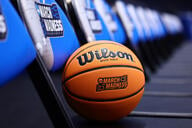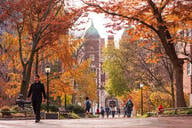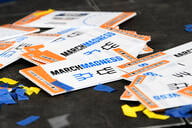You have /5 articles left.
Sign up for a free account or log in.
INDIANAPOLIS – Choosing a major is difficult for many students. But for athletes, especially those on scholarship who never planned to (as the National Collegiate Athletic Association says) “go pro in something other than sports,” the decision is often complicated by the hard truth that they’ll have to.
And it’s not hard only for them. Presenting a study of athletes’ career goals and how they were formed, Kristina M. Navarro, an assistant professor of education at the University of Wisconsin at Whitewater, talked with attendees here at the annual American College Personnel Association conference about how parents can help or hurt their kids’ scholarly pursuits.
Only 3.02 percent of athletes, across sport and gender, actually turn professional. Yet 12 percent of athletes in Navarro’s study had the goal of doing so (28 percent aspired to some sports-related career).
“We as student affairs professionals need to figure out what to do with them,” Navarro said. “We have our work cut out for us.”
Athletes report that their career preparation and choices evolve throughout their time in college, so there’s plenty of time to work with those who may need a reality check. (Many who had professional sport aspirations and a seemingly unrelated major planned on graduate school.) But overcoming a strong push from those parents who are telling their kids “get a scholarship, be a professional,” could be difficult, Navarro said.
For some conference attendees, it has been.
“The people who don’t know what they want to major in or who are unsure…. Usually their parents are pushing them into a career that they are not academically prepared for,” one athletic adviser said. (Of course, the same could often be said for non-athletes.) “How do you say, ‘I appreciate that your parents are a strong influence, but you aren’t smart enough to be a doctor?’ or ‘You’re not good at science; why do you want to be a doctor?’ ”
As athletes explore and choose career paths, Navarro said, they’re struggling to balance their roles as both students and players. More Division I athletes than ever before are academically underprepared, and many who had prematurely committed to a life of sport may end up floundering or clustering in the easiest majors.
In fact, the athletes who wanted to go pro for the most part flocked toward general or interdisciplinary studies – “the jock majors,” as Navarro put it.
The qualitative study included 29 Division I athletes who are seniors at a large Midwestern university. While most of the male athletes were football players (eight of 13), the women were more evenly spread across sports.
Male athletes were less likely to have aligning majors and career aspirations. Many wanted to stay in sports in some way, either by playing at the next level or working in the field; for example, one track athlete studying sociology wanted to be a physical therapy assistant.
Female athletes, on the other hand, tended to align more logically (many studied education).
Male athletes in non-revenue sports whose parents were alumni or veterans of their sport, and non-first-generation students were most likely to report strong parental influence (for women from their moms, and for men from their dads).
But what does that influence translate into? Well, nearly 90 percent of athletes who aspired to go pro had fathers who worked in sports. The follow-in-my-parents’-footsteps theme showed up for athletes with non-sports aspirations, too (especially among men). Across the board, 86 percent of athletes who did not aspire to turn professional said they want a job similar to a parent’s.
One woman here described getting a voicemail the week before, from an athlete’s grandmother who wanted her grandson placed in sport management classes because she “thought the athlete would like them.”
But, on the whole, advisers suggested that involving parents and others can actually be helpful. Involving them in first-year orientation, either at in-person talks or with newsletters, can get the students off on the right foot and instill trust in parents that advisers generally know what works and what doesn’t. In turn, the advisers can get started assessing students’ strengths and helping them explore different careers and try different courses early and often.
“Especially for Division I athletes, the coaches and the teammates become like the family,” Navarro said in an interview last week. “If you can enhance the relationship between the real family and the athletic family, then everybody’s on the same page.”
About 62 percent of participants were on full scholarship, and felt most strongly that they were helped by and felt safe with athletics student affairs employees. And 17 percent of first-generation students cited those staff members or others outside the home (such as professors or youth sport coaches) as most influential on their career development.
“Athletics departments need to work with higher education institutions,” to make sure these athletes get the resources and support they need on all sides, Navarro said, “and need to work with student affairs officers outside of athletics so that we can kind of bridge this gap.”




